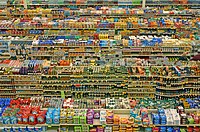
Photo from wikipedia
* Correspondence: [email protected]. edu.cn; [email protected] National Key Laboratory of Crop Genetic Improvement, Huazhong Agricultural University, Wuhan 430070, China Challenges in food production Global population has reached up to 7.8 billion… Click to show full abstract
* Correspondence: [email protected]. edu.cn; [email protected] National Key Laboratory of Crop Genetic Improvement, Huazhong Agricultural University, Wuhan 430070, China Challenges in food production Global population has reached up to 7.8 billion and is expected to exceed 10 billion by 2055 (https://countrymeters.info/cn/World). Such rapid population increase presents a great challenge for food supply. On the one hand, more grains are needed to provide basic calories for humans. On the other hand, the rising living standard leads to a changing diet habit towards higher average consumption of livestock and dairy products, especially in developing countries. Thus, crop yield boost is needed to fill the gap between food production and demand. Meanwhile, food nutritional values are of more interest to accommodate industrialized modern lives. The instability of food production caused by global climate change is another great challenge. Since 1880, the earth’s temperature has risen by more than one degree (https://earthobservatory.nasa.gov/world-of-change/global-temperatures), and the warming rate is becoming more rapid in recent decades, with more frequent extreme climate change including high temperature, drought, and floods. This requires future crops to adapt to this new and unpredictable environment. Crop varieties resistant to biotic stresses are also needed as plant disease and insects are expected to be impacted by climate change. More importantly, we need a food production system that can simultaneously satisfy societal demands and long-term development. Since the Green Revolution in the 1960s, farming is heavily dependent on high input of nitrogen and pesticides. This leads to environmental pollution which is not sustainable in the long run. Therefore, a new breeding scheme is urgently needed to enable sustainable agriculture; including new strategies to develop varieties and crops that have high yield potential, high yield stability, and superior grain quality and nutrition; nevertheless, less consumption of water, fertilizer, and chemicals should also be considered for environmental protection purposes.
Journal Title: Genome Biology
Year Published: 2020
Link to full text (if available)
Share on Social Media: Sign Up to like & get
recommendations!